
Original Link: https://www.anandtech.com/show/1932
Intel D975XBX: Intel brings their Bad-Axe to Market
by Gary Key on January 26, 2006 12:05 AM EST- Posted in
- Motherboards
"Expectation is the root of all heartache."
This quote by noted playwright William Shakespeare expresses our opinion about the Intel D975XBX. Although motherboards from Intel have generally been designed and offered for the business, education, or home office user, they have been directing their efforts towards the enthusiast market recently. In fact, Intel has loosened their white collars and taken off the blue suits with the introduction of the Extreme Series product line last year. Well, that might be an overstatement when compared to other enthusiast product offerings based on Intel chipsets, but Intel does recognize the importance of the gaming and advanced user in the marketplace.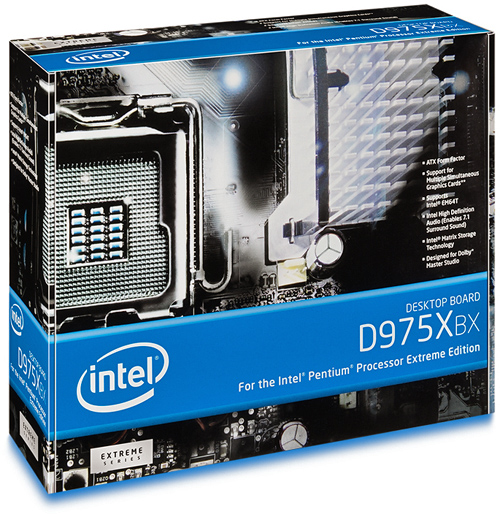
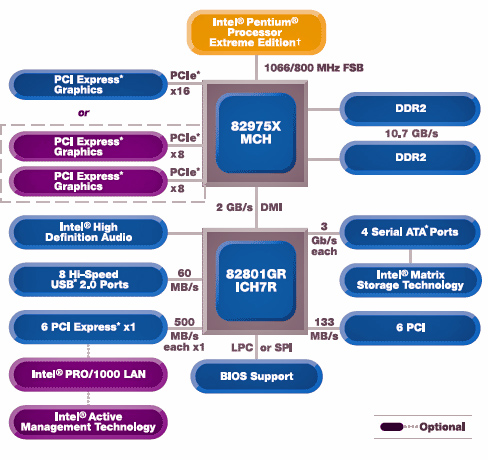
The Intel MPT is enhanced over the 955X iteration to offer improved pipelining to enable a higher utilization of each memory channel, resulting in better performance through increased transfers between the processor and system memory. Intel Flex Memory Technology allows different memory sizes to be populated and still remain in dual-channel mode.
The new architecture also supports both asynchronous and isochronous data traffic, with dedicated internal pipelines and specialized arbitration. In addition, the 975X chipset has improved electricals with optimized ball-out for better latency compared to the 955X chipset. We noticed small, but not significant improvements in our test results.
Intel chose to augment this feature set with additional SATA capabilities via the Silicon Image SiI 3114 chipset, and Firewire 1394a support via the TI TSB43AB23 chipset.
Let's find out if the board met our expectations or left us with heartache.
Basic Features: Intel D975XBX
| Specification | Intel D975XBX |
| CPU Interface | LGA775-based Pentium 4, Pentium 4 XE, Celeron D, and Pentium D processors |
| Chipset | Intel 975X - MCH ICH7R - ICH |
| Pentium D Support | 820D, 830D, 840D, 840EE, 920D, 930D ,940D ,950D , 955EE |
| Front Side Bus | 1333 / 1067 / 800 / 533 MHz |
| Host Burn-In Mode | 0 - 30% (in 1 percent increments) |
| Memory Speeds | Default, DDR-2 333, 400, 533, 667, and 800MHz |
| PCI Bus Speeds | Default, 40.00MHz |
| PCI Express Bus Speeds | Default, 101.32, 102.64, 103.96, 105.28, 106.6, 107.92, 109.24MHz |
| Set Processor Multiplier | 12 to 40, (in 1 step increments) |
| Core Voltage | Default, 1.2750V to 1.6000V (in 0.0125V increments) |
| DRAM Voltage | Default, 1.80V, 1.90V, 2.00V, 2.10V, 2.20V |
| MCH Chipset Voltage | Default, 1.525V, 1.600V, 1.650V, 1.725V |
| FSB Termination Voltage | Default, 1.271V, 1.333V, 1.395V |
| Memory Slots | (4) x DIMM, max. 8GB, DDR2 667/533/400, non-ECC, ECC, un-buffered memory |
| Expansion Slots | (2) x PCI-E x16 (operates in 1x16 and 1x8 or 2x8 mode) (1) x PCI-E x16 (operates in x4 mode) (2) x PCI 2.3 |
| Onboard SATA | Intel ICH7R: (4) x SATA 3Gb/s |
| Onboard IDE | Intel ICH7R: (1) x UltraDMA 100/66/33 |
| SATA/IDE RAID | Intel ICH7R: (4) x SATA 3Gb/s RAID 0, RAID 1, RAID 5, RAID 10, and Intel Matrix Storage technology Silicon Image SiI 3114: (4) x SATA 1.5Gb/s RAID 0, RAID 1, RAID 0+1 (operates on PCI bus) |
| Onboard USB 2.0/IEEE-1394 | (8) USB2.0 ports (2) IEEE 1394a FireWire Ports by TI TSB43AB23 |
| Onboard LAN | Intel 82573L PCI-E x1 Gb LAN |
| Onboard Audio | Sigmatel STAC9221D, 8-channel capable HD Audio Codec featuring Dolby Master Studio technology |
| Power Connectors | 24-pin ATX 4-pin 12V Plug 8-pin EATX 12V |
| Back Panel I/O Ports | 1 x PS/2 Keyboard 1 x PS/2 Mouse 1 x Parallel 1 x Serial 1 x Audio I/O Panel 1 x Optical S/PDIF Out Port 1 x Coaxial S/PDIF Out Port 1 x RJ45 4 x USB |
| Other Features | Value Added Software: Intel® Audio Studio Intel® Desktop Utilities Intel® Desktop Control Center InterVideo* WinDVD* Ulead* VideoStudio* 9 SE DVD InterVideo* MediaOne* Gold Musicmatch* Jukebox Farstone RestoreIT!* Gold Farstone Gamedrive* Norton* Internet Security Norton* AntiVirus Yahoo!* Toolbar with Anti-spy |
| BIOS | Intel 0420 (01/05/2006) |
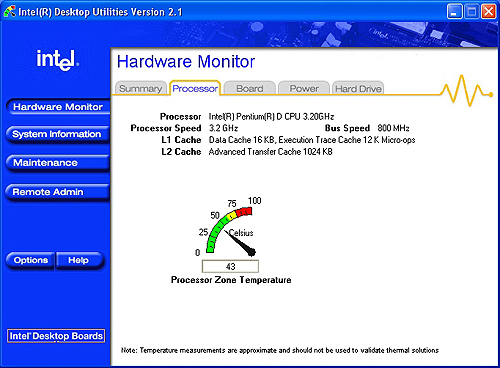
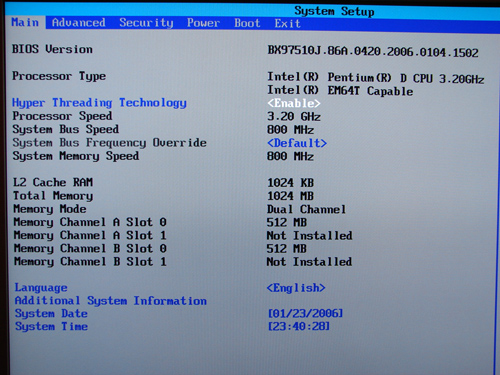

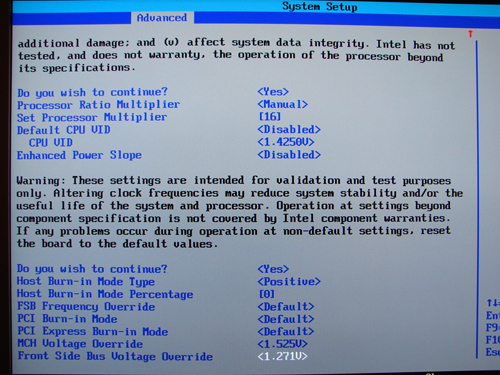
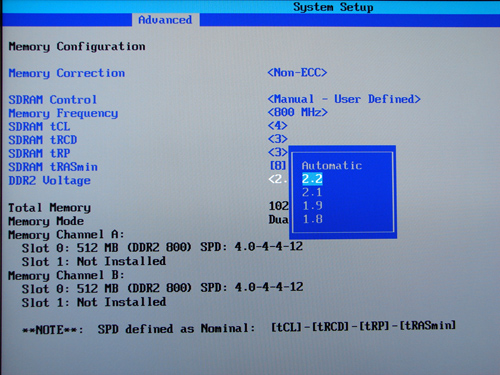
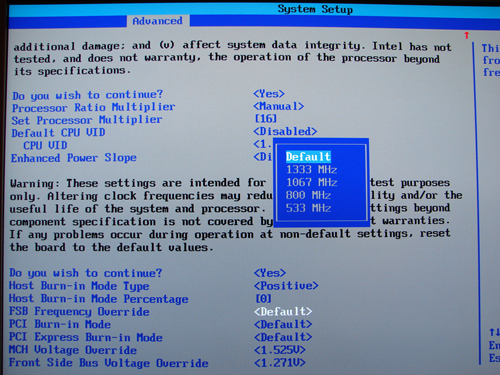
INTEL D975XBX: Features

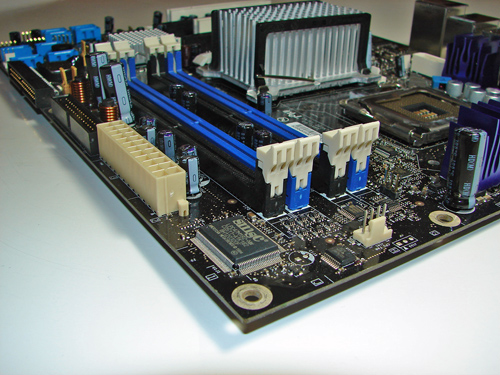
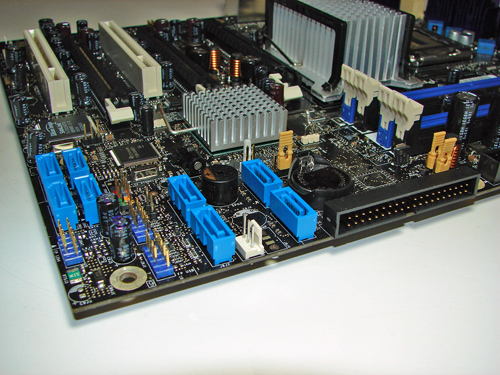
The Intel SATA ports are conveniently located below the ICH7R chipset and to the left of the primary IDE connector. The SATA ports feature the new clamp and latch design. Unlike other 975x boards, the SATA ports are not color-coded for primary and secondary operation. We found the positioning of the SATA ports to be excellent when utilizing the ATI CrossFire cards in the primary and secondary PCI Express connectors.
The Silicon Image SiI 3114 SATA RAID port connectors are clustered on the left edge of the board. The Intel USB connectors and chassis panel are located below the SiI 3114 port connectors and to the left of the Intel SATA port connectors. The BIOS configuration jumper block is a traditional jumper design located above the IDE port connector. The location of this jumper was acceptable during repeated usage.
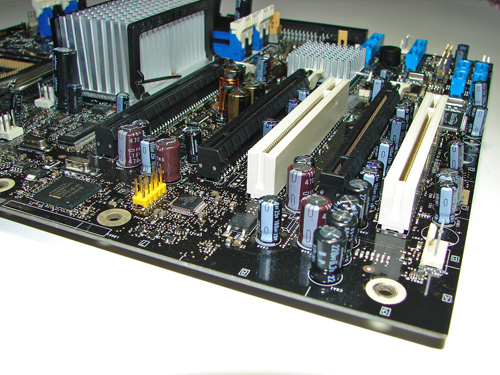
The first physical x16 connector located next to the MCH heat sink is the primary PCI Express connector and is set up for electrical routing in x16 or x8 operation. The x16 interface supports full duplex transfers up to 8 GBytes/second in x16 operation and single-ended transfers are supported up to 4 GBytes/second in x8 operation.
The next physical x16 connector is the secondary PCI Express connector and is set up for electrical routing in x8 operation. This connector also fully supports x4 and x1 PCI Express add-in cards. The final physical x16 connector is set up for electrical routing in x4 operation and fully supports x4 or x1 PCI Express add-in cards.
We did not have any issues installing an ATI X850 Crossfire Edition setup in the primary and secondary x16 PCI Express slots. This configuration will physically render the first PCI slot useless. There were no issues utilizing this slot with video cards containing single slot cooling systems.
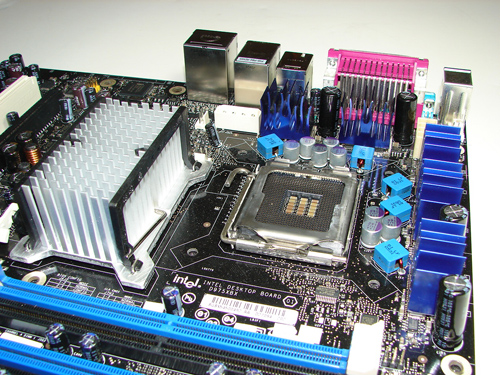
The MCH and ICH chipsets are passively cooled with heat sinks that do not interfere with any installed peripherals. In fact, this system kept the chipsets cool enough that additional chipset voltage was not a factor in our overclocking tests. Intel places the eight-pin 12V auxiliary power connector at the top of the CPU socket area, but out of the way of most aftermarket cooling solutions. However, the 4-pin auxiliary power connector is located in a difficult position and can hamper airflow with cabling that crosses over the heat sink.
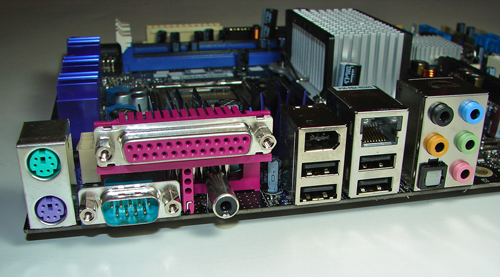
FSB Overclocking Results
| Front Side Bus Overclocking Testbed | |
| Processor: | Pentium 4 Smithfield LGA 775 840EE Dual Core 3.2GHz |
| CPU Voltage: | 1.5125V (1.4000V default) |
| Memory Settings: | 3-2-2-8 at 667MHz |
| Memory Voltage: | 2.2V |
| MCH Voltage: | 1.60V |
| ICH Voltage: | Default |
| Cooling: | Thermaltake Big Typhoon |
| Power Supply: | OCZ Power Stream 520 |
| Maximum CPU OverClock: | 200fsb x 20 (4000MHz) +25% |
| Maximum FSB OverClock: | 260fsb x 15 (3900MHz) +30% |
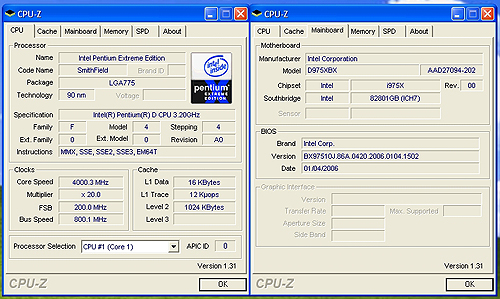
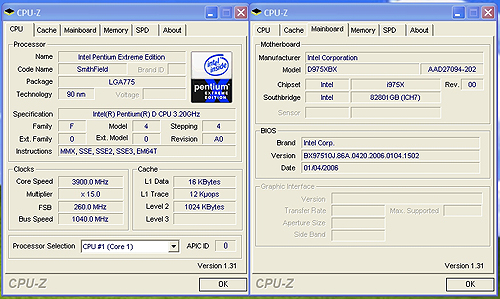
We tried two other boards, but we did not have success in increasing the CPU multiplier past 20 or utilizing a combination of the CPU multiplier and the FSB frequency override setting past the reported numbers. Even though this particular CPU has reached 4.4GHz, we could not pass the 4.0GHz mark and maintain stability or complete our test suite. We will be receiving a retail board shortly and will re-examine the overclocking ability of the board with our 840EE, 950D, and 955EE processors.
Memory Stress Testing
Memory stress tests look at the ability of the Intel D975XBX to operate at the officially supported memory frequencies of 667MHz DDR2, at the best performing memory timings that the Corsair CM2X512A-5400UL revision 1.3 will support.
| Intel D975XBX Stable DDR667 Timings - 2 DIMMs (2/4 slots populated - 1 Dual-Channel Bank) |
|
| Clock Speed: | 200MHz (800FSB) |
| Timing Mode: | 667MHz - Default |
| CAS Latency: | 3 |
| RAS to CAS Delay: | 2 |
| RAS Precharge: | 2 |
| RAS Cycle Time: | 8 |
| Voltage: | 2.1V |
The Intel D975XBX was very stable with 2 DDR2 modules in Dual-Channel at the settings of 3-2-2-8 at 2.1V. We will now install all four available memory slots that are usually more strenuous on the memory subsystem than testing 2 DDR2 modules on a motherboard.
| Intel D975XBX Stable DDR667 Timings - 4 DIMMs (4/4 slots populated - 2 Dual-Channel Banks) |
|
| Clock Speed: | 200MHz (800FSB) |
| Timing Mode: | 667MHz - Default |
| CAS Latency: | 4 |
| RAS to CAS Delay: | 2 |
| RAS Precharge: | 3 |
| RAS Cycle Time: | 8 |
| Voltage: | 2.2V |
The Intel D975XBX was completely stable with 4 DDR2 modules in Dual-Channel at the settings of 4-2-3-8 and needed the voltage increased to 2.2V. We tried several combinations of memory settings at the CAS Latency of 3, but the board was not stable enough to complete our test suite. This is the first i975x board that we have tested that did not allow a CAS Latency of 3 in our testing with 4 DDR2 modules.
Test Setup
The Intel 975X chipset fully supports all dual core Pentium D processors in both stock and overclocked conditions. This chipset also supports the upcoming Cedar Mill processor range. Dual core really makes a difference in certain multi-tasking scenarios, as was demonstrated in the dual core performance preview. If you are interested in how the various chipsets perform in a real world multitasking setup, please take another look at that review.
| Performance Test Configuration | |
| Processor(s): | Intel Pentium 840EE (3.2GHz, 800FSB, Dual-Core, 2x1MB L2, HT) utilized for all tests |
| RAM: | 2 x 512MB Corsair CM2X512A-5400UL revision 1.3 Settings- DDR2-667 as noted at (CL3-2-2-8) |
| Hard Drive(s): | 2 x Maxtor MaXLine III 7L300S0 300GB 7200 RPM SATA (16MB Buffer), 1 x Maxtor MaXLine III 7L300R0 300GB 7200 RPM IDE (16MB Buffer) |
| System Platform Drivers: | Intel Chipset Software - 7.2.2.1006 NVIDIA Platform Driver - 6.82 |
| Video Cards: | 1 x XFX 7800GTX OC (PCI Express) for all tests |
| Video Drivers: | NVIDIA nForce 81.98 WHQL |
| Cooling: | Thermaltake Big Typhoon |
| Power Supply: | OCZ Power Stream 520 |
| Operating System(s): | Windows XP Professional SP2 |
| Motherboards: | Intel D975XBX Asus P5WD2-E Asus P5N32-SLI Deluxe Gigabyte GA-G1 975X Asus P5WDG2-WS |
General Performance & Encoding
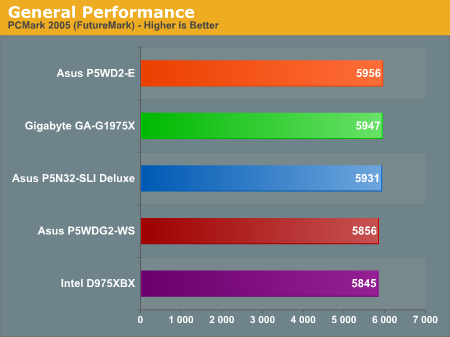
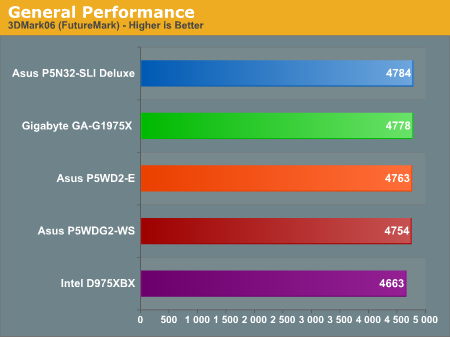

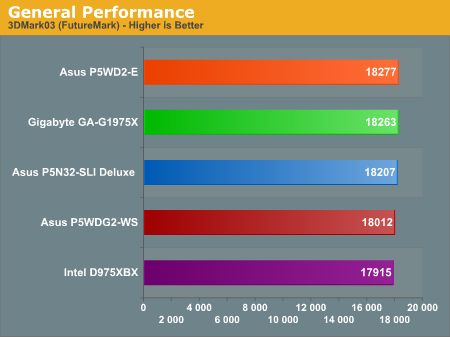
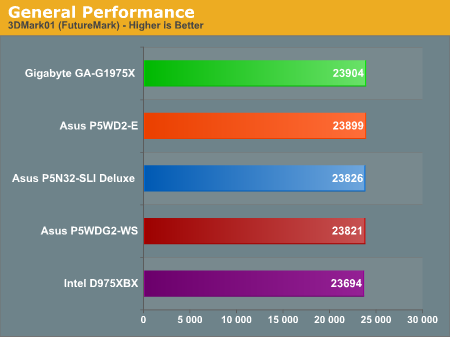
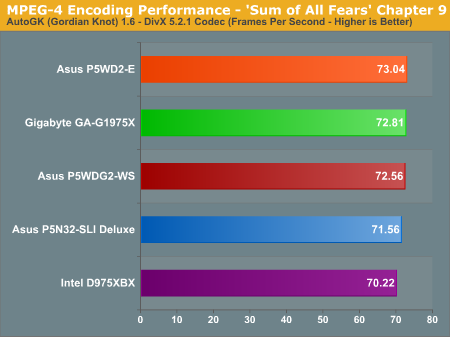
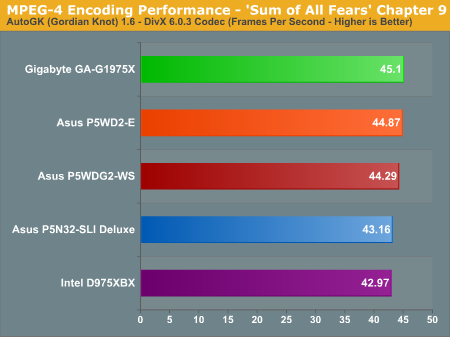
Memory Performance
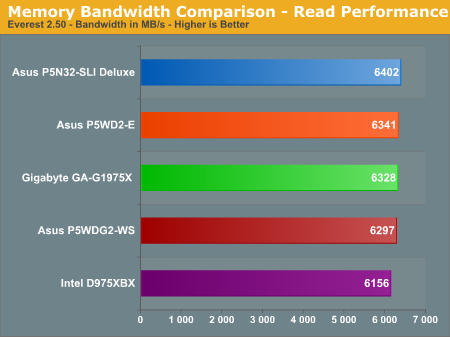
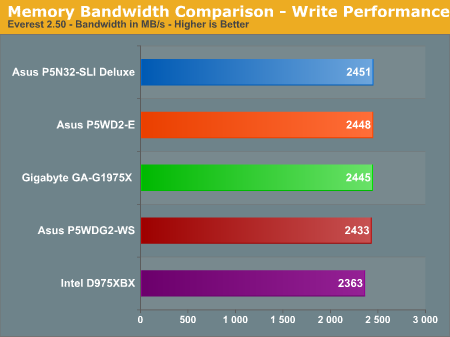

Overclocking Performance
The overclocking performance graphs have been added to the standard benchmark test suite and should allow for a better comparison on the overclocking capabilities of tested boards. For more details on the specific overclocking abilities of this board, please refer to the Overclocking and Memory Stress Test section in the Basic Features section.

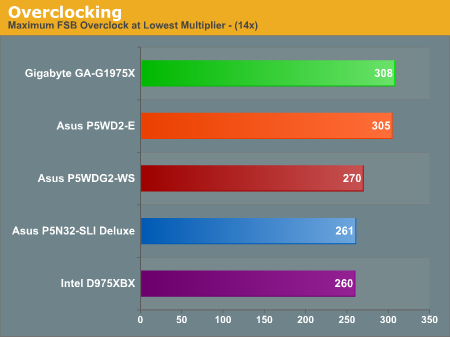
Gaming Performance
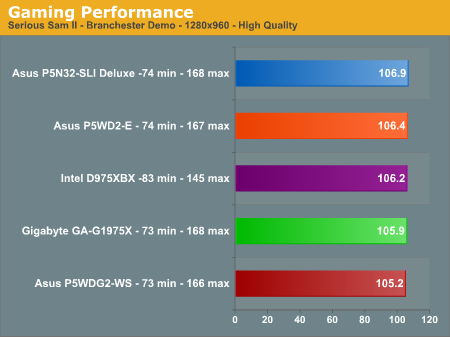
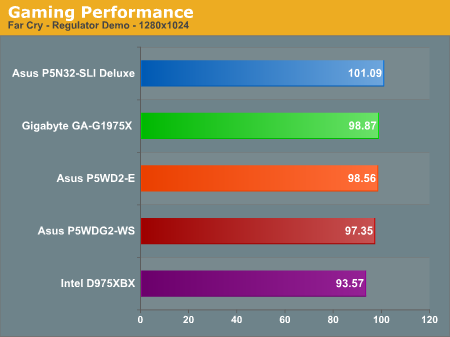
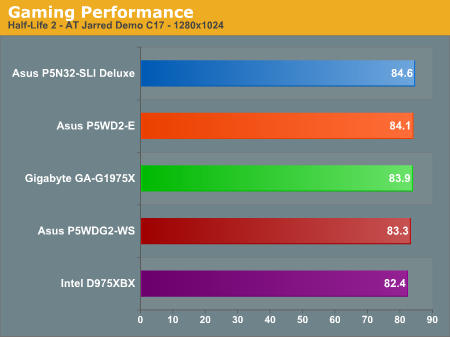
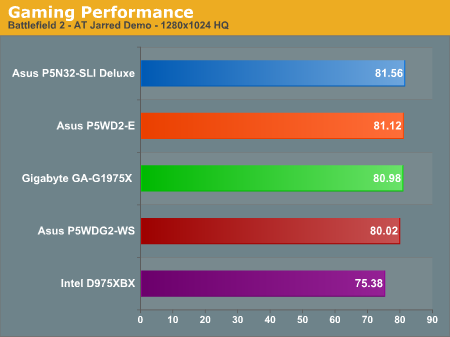

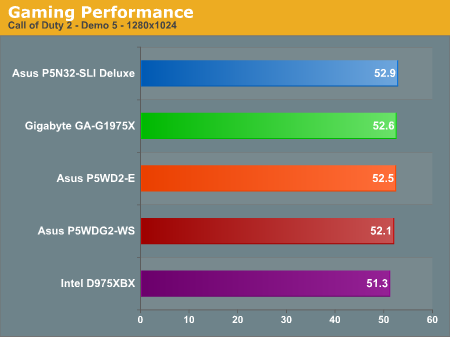
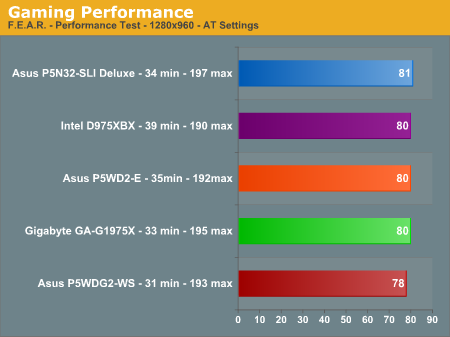
Disk Controller Performance
With the variety of disk drive benchmarks available, we needed a means of comparing the true performance of the wide selection of controllers. The logical choice was Anand's storage benchmark first described in Q2 2004 Desktop Hard Drive Comparison: WD Raptor vs. the World. The iPeak test was designed to measure "pure" hard disk performance, and in this case, we kept the hard drive as consistent as possible while varying the hard drive controller. The idea is to measure the performance of a hard drive controller with a consistent hard drive.
We played back Anand's raw files that recorded I/O operations when running a real world benchmark - the entire Winstone 2004 suite. Intel's iPEAK utility was then used to play back the trace file of all IO operations that took place during a single run of Business Winstone 2004 and MCC Winstone 2004. To try to isolate performance differences to the controllers that we were testing, we used the Maxtor MaXLine III 7L300S0 300GB 7200 RPM SATA drive in all tests. The drive was formatted before each test run and a composite average of 5 tests on each controller interface was tabulated in order to ensure consistency in the benchmark.
iPeak gives a mean service time in milliseconds; in other words, the average time that each drive took to fulfill each IO operation. In order to make the data more understandable, we report the scores as an average number of IO operations per second so that higher scores translate into better performance. This number is meaningless as far as hard disk performance is concerned as it is just the number of IO operations completed in a second. However, the scores are useful for comparing "pure" performance of the storage controllers in this case.
Our testing results in RAID 5, 0, and 1 with the Intel ICH7R was successful, but we did not have time to properly complete testing of the other storage controllers for this article. We will have published RAID results for all tested boards in our 975X roundup along with results from the NVIDA based P5N32-SLI.
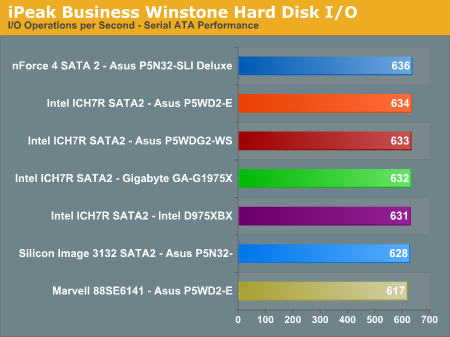
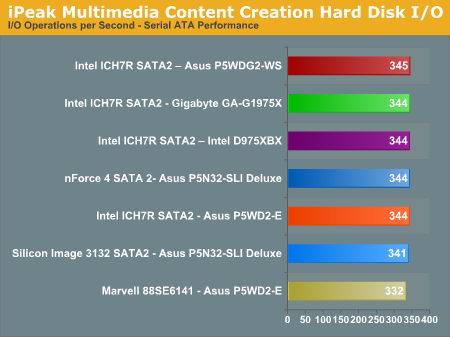
Firewire and USB Performance
After looking at many options for Firewire and USB testing, we finally determined that an external USB 2.0, Firewire 400, and Firewire 800 hard disk would be a sensible way to look at USB and Firewire throughput.
Our first efforts at testing with an IDE or SATA drive as the "server" yielded very inconsistent results, since Windows XP sets up cache schemes to improve performance. Finally, we decided to try a RAM disk as our "server", since memory removed almost all overhead from the serving end. We also managed to turn off disk caching on the USB and Firewire side by setting up the drives for "quick disconnect" and our results were then consistent over many test runs.
We used 1GB of fast 3-2-2-8 system memory set up as a 450MB RAM disk and 550MB of system memory. Our standard file is the SPECviewPerf install file, which is 432,533,504 bytes (412.4961MB). After copying this file to our RAM disk, we measured the time for writing from the RAM disk to our external USB 2.0, Firewire 400, or Firewire 800 drive using a Windows timing program written for AnandTech by our own Jason Clark. The copy times in seconds were then converted into Megabits per second (Mb) to provide a convenient means of comparing throughput. Higher Rates therefore mean better performance in this particular test.
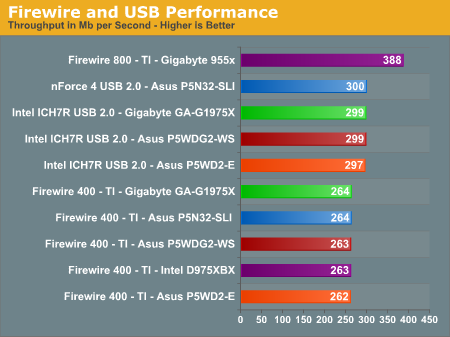
Ethernet Performance
The current motherboard test suite includes LAN performance measurements. All of these boards utilize PCI Express controllers with the only difference being the supplier of the core logic.
The Windows 2000 Driver Development Kit (DDK) includes a useful LAN testing utility called NTttcp. We used the NTttcp tool to test Ethernet throughput and the CPU utilization of the various Ethernet Controllers used on the Intel 975x motherboards.
We set up one machine as the server; in this test, an Intel system with an Intel CSA Gigabit LAN connection. Intel CSA has a reputation for providing fast throughput and this seemed a reasonable choice to serve our Gigabit LAN clients.
At the server side, we used the following Command Line as suggested by the VIA whitepaper on LAN testing:
Ntttcpr -m 4,0,‹server IP› -a 4 -l 256000 -n 30000On the client side (the motherboard under test), we used the following Command Line:
Ntttcps -m 4,0,‹client IP› -a 4 -l 256000 -n 30000At the conclusion of the test, we captured the throughput and CPU utilization figures from the client screen.
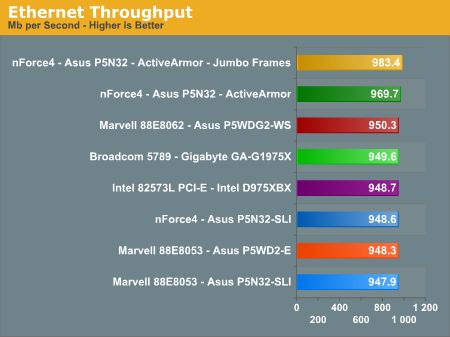
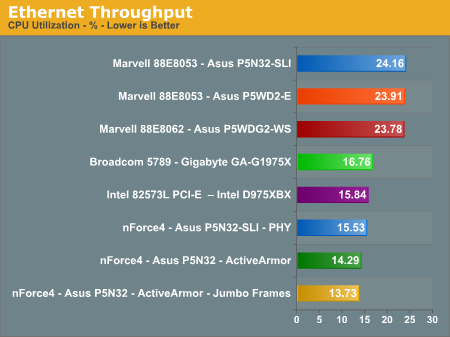
All standard Ethernet tests were performed with standard frames and the NVIDIA Active Armor suite disabled unless otherwise noted. Gigabit Ethernet supports Jumbo frames as well and provides a further reduction in CPU overhead. We added another test scenario in which ActiveArmor and Jumbo frames were enabled on the Asus P5N32-SLI Deluxe board via the 6.82 WHQL platform driver set. This is shown for illustrative purposes and shows the favorable impact of this technology.
Audio Performance
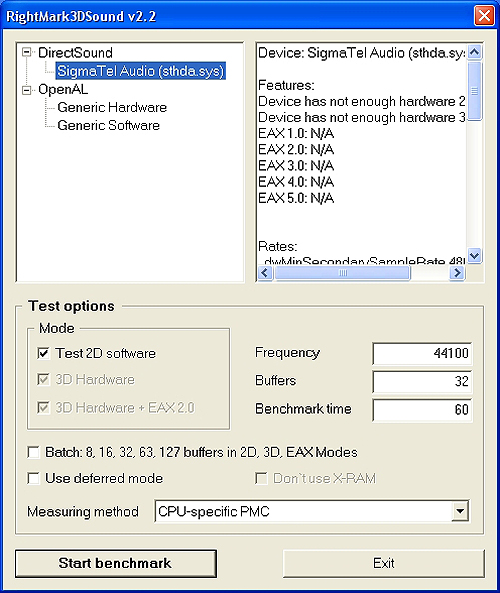
The Sigmatel STAC9221D codec on the Intel D975XBX board does not fully support 3D Hardware, EAX1, or EAX2 modes as the other on-board codecs do at this time. Consequently, its performance is highly dependent upon the CPU and gaming support will be limited to generic OpenAL or 2D modes.
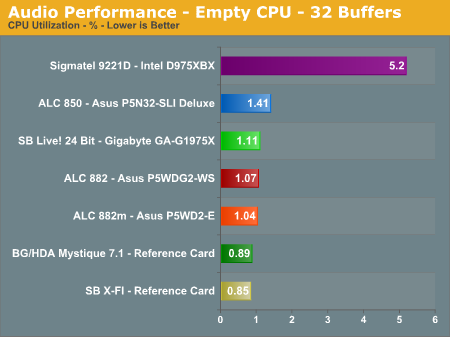

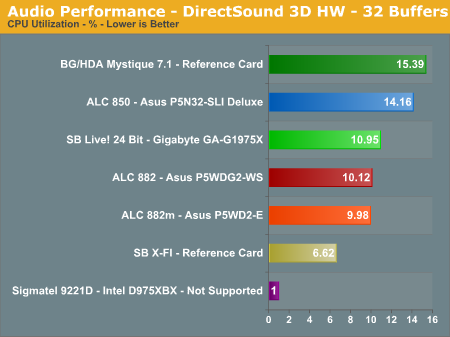
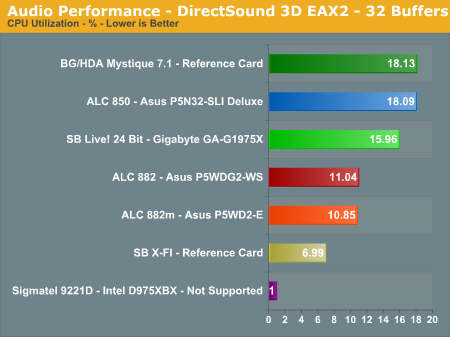
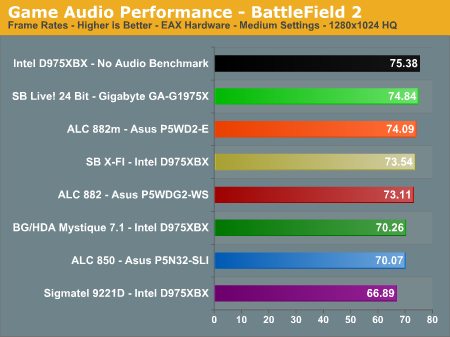
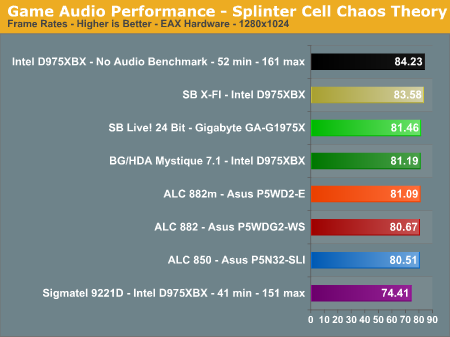
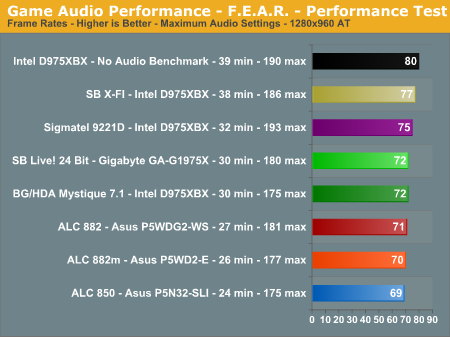
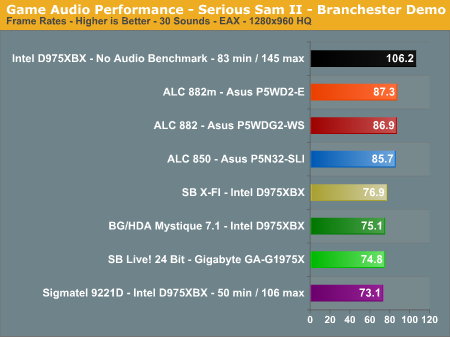
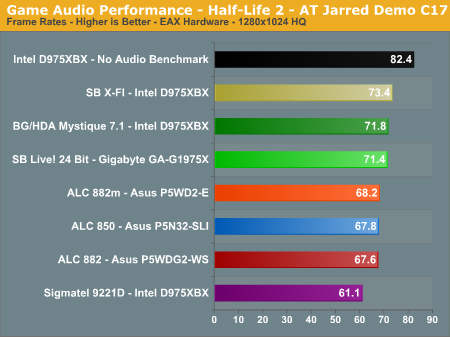
Obviously, if you are a serious gamer, then a dedicated sound card is still a requirement to ensure consistent frame rate averages across a wide variety of games. We noticed in our Battlefield 2, Serious Sam II, and Half Life 2 testing that the ALC882M solution would stutter in intensive scenes, creating frame rates in the low teens momentarily. We will be testing the Realtek R1.30 drivers in our next article to see if the minimal frame rates and stutter issues have been improved.
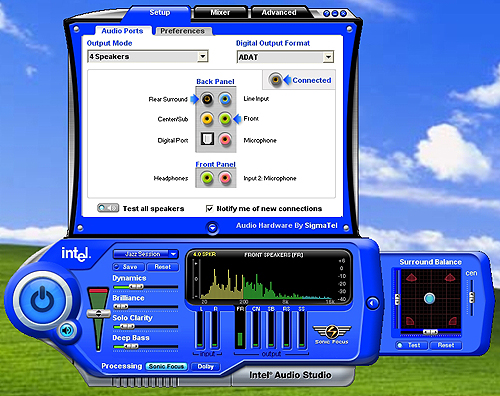
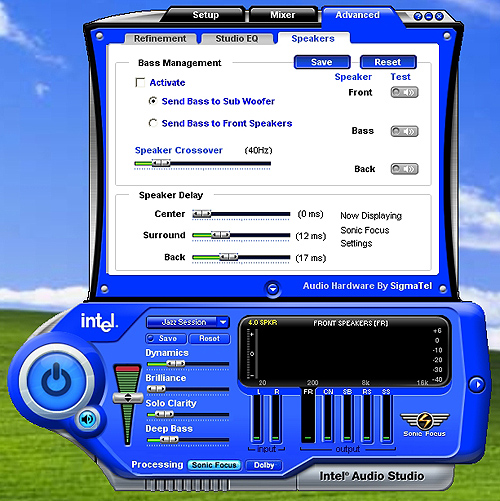
Final Words
The Intel D975XBX is an interesting solution for the Intel Enthusiast at this time. The performance of the board was average or below in all testing phases while stability was superb. In fact, unless we were overclocking the board past its obvious limits, we never experienced any stability issues. Unlike other boards reviewed recently, we did not find any test issues with our peripheral inventory. The Intel D975XBX exemplifies Intel's trend of offering very stable and secure board solutions with excellent documentation and support.
With that said, let's move on to our performance opinions regarding this board.
In the video area, the inclusion of two physical PCI Express x16 slots that fully supports x8 bandwidth operation for dual graphics cards is a valuable feature for the workstation user or enthusiast. The board fully supports ATI CrossFire mode in our internal testing. We are waiting on a X1900XT MasterCard to arrive for further CrossFire testing, but we did not discover any issues with the X850XT CrossFire solution and 6.1 driver set.
In the on-board audio area, this board offers the Sigmatel STAC9221D High Definition audio codec. The excellent Intel Audio Studio software suite provides Jack-Sensing, S/PDIF Out support, interrupt capability, and Dolby Master Studio support among other options. The audio output of this codec in the music, video, and DVD areas is very good to excellent. The audio quality in gaming was acceptable, but the performance was mediocre considering the lack of EAX compatibility. If you plan on utilizing this board for gaming, then our only recommendation is to purchase an appropriate sound card. Further information about the Sigmatel family of HD audio codecs can be found here.
In the storage area, the Intel board offers a wide variety of storage options with additional SATA RAID ports. The board fully offers Intel's excellent Matrix RAID system and offers Hot Swap, NCQ, and 3Gb/s capability. Intel supplements their native SATA capability with the Silicon Image SiI 3114 SATA chipset featuring support for Hot Swap and 1.5Gb/s operation. The SiI 3114 resides on the PCI bus and Intel's implementation is for RAID 0, 1, and 0+1 operation only. The board offers the standard eight Intel USB ports and two IEEE 1394a ports utilizing the TI TSB43AB23 chipset. However, we believe that Firewire 800 should have been offered on this board, since it was included on the D955XBK.
In the performance area, the Intel D975XBX generated scores that were lower than the other boards in most benchmarks. The overall performance of the board was disappointing at times, but was within range of the other 975x offerings. The stability of the board was superb during testing and the results in certain game benchmarks offer hope for improvement in the future. We will review the performance of this board again when our retail version arrives and then update our findings.
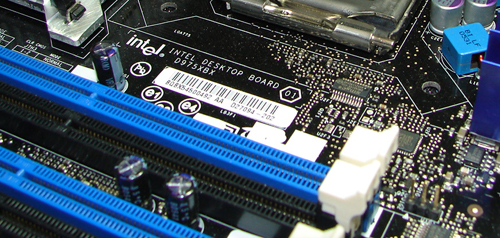
Intel took a few steps forward with the board and yet at the same time, it took a few steps back. Intel did rectify the D955XBK cooling issues around the MOFSETS and increased the stability of the board with the 5-phase power regulation system. The inclusion of true x8 operability for the primary and secondary PCI Express connectors along with full ATI CrossFire support addressed the lack of performance for multiple GPU solutions. The improved BIOS options and increased voltages are a step in the right direction and shows that Intel is trying to match other suppliers in their ability to increase performance.
However, we feel that Intel made the following errors in the design and execution of a board targeted to the "advanced gamer and power-user". The entire process of setting up the BIOS in the advanced section for overclocking should be simplified. If Intel is serious about targeting the enthusiast user, then the question and answer section in the BIOS needs to be dropped. The process for overclocking the system via FSB adjustments needs to change from a fixed percentage rate to the ability to enter a FSB value. The voltage, memory frequencies, and bus options need to be further expanded. The BIOS needs to be able to self-recover when the board is unable to boot at extended settings. The current shutdown/jumper/startup process ensures frustration on the user's behalf. The bottom line is: if you are going to allow overclocking, then make it as user-friendly as possible.
The inclusion of the SiI 3114 RAID chipset is an error when the excellent SiI 3132 is available at this time. The SiI 3132 is a PCI Express device unlike the SiI 3114 and offers NCQ, Port Multiplier, and 3Gb/s support. The removal of FireWire 800 support that was offered on the D955XBK board is also an error.
We certainly look forward to Intel's next enthusiast board as they definitely are on the right path. Our expectations were quite high for this board, but it has left us with heartache, as it could have been much more.







